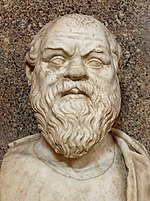The Death of Socrates is recounted in several ancient works including Plato’s dialogue “Phaedo” and “The Apology” and in Xenophon’s “The Apology of Socrates to the Jury“.
Socrates death by execution in 399 BC is credited to be a point from which western philosphy can find its origins. The classical Greek philosopher and teacher was put on trial and executed for “corrupting” the youth of Athens. His crimes – to introduce strange gods and for “impiety“, disbelieving in the gods of the state.
In fact, Socrates disagreed with the powerholders of Athens and refused to be silenced. Instead of accepting what he perceived as immorality within his region, he questioned their notion of “might makes right“. His attempts to improve the Athenians’ sense of justice led to his trial and death.
Socrates defended his role as a “gadfly” – a small creature that stings but spurs a beast into action.
At his trial, when Socrates was asked to propose his own punishment, he suggested a wage paid by the government and free dinners for the rest of his life instead, to finance the time he spent as Athens’ benefactor.
He was, however, found guilty of both corrupting the minds of the youth of Athens and of impiety and subsequently sentenced to death by drinking a mixture containing poison hemlock.
Shortly before his death, Socrates spoke his last words to Crito:
Crito, we owe a rooster to Aesclepius. Please, don’t forget to pay the debt.
Aesclepius was the Greek god for health and healing, and it is likely Socrates’ last words meant that death is the cure—and freedom, of the soul from the body.
Additionally, in Why Socrates Died: Dispelling the Myths, Robin Waterfield proposes that Socrates was a voluntary scapegoat; his death was the purifying remedy for Athens’ misfortunes.
Interestingly, the Rod of Aesclepius, and the symbol of places of healing throughout the Greek world, was a snake curled around a stick. The symbol to this day is associated with health and health care.
Some commentators have linked the symbol to the serpent wrapped around a pole mentioned in the Bible in the Book of Numbers (Numbers 21:5–9).
9 And Moses made a serpent of brass, and put it upon a pole, and it came to pass, that if a serpent had bitten any man, when he looked upon the serpent of brass, he lived.
King Hezekiah, 700 years later destroyed the copper serpent because it was being worshiped (2 Kings 18:4).
The motif appears again as a symbol of healing in the New Testament, this time a messianic symbol found in John 3:14–15.
14 And as Moses lifted up the serpent in the wilderness, even so must the Son of man be lifted up: 15 That whosoever believes in him should not perish, but have eternal life.
Fascinating parallels emerge. Socrates, perished, a voluntary scapegoat. His death was to him, and to generations subsequent, a cure, a freedom from the tyranny of odious traditions and false wisdom. Western philosophy has forever been indebted to the iconoclast for his steadfast dedication to inquiry, justice, and the rights of the common man.
At another turning point in history, Christ died, a voluntary scapegoat for the ills of his people. His death too has been for generations subsequent, a cure, freedom from the tyranny of odious traditions, false wisdom and well …….eternal death.






I suppose there are parallels between Socrates and Jesus Christ, now that you lay them out so clearly. If the accounts we have reflect the historical reality, neither death seem just. On the other hand, I wonder if either of these figures would had anything like their present influence had they not died.
Thanks again! Yes their death definitely turned history. The dying hero is a common theme throughout cultures.
Jennifer
>